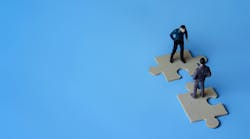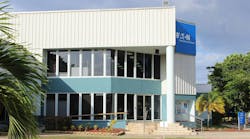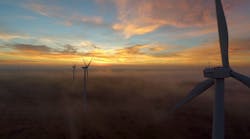Just when you think you know everything there is to know about lighting, a new design comes up, a market emerges or someone demonstrates a fresh product. Maybe, for you, fiber-optic (FO) lighting is that new thing. Continuously developed over two decades, FO lighting is generating interest among lighting designers, electrical contactors and engineers because of its challenges and complexity.
The first part of this two-parter discussed system components and types of fixtures; it also defined technology terms and concepts. Now, let's learn about advantages of fiber-optic lighting, taking a look at possible turns the technology will take in the future.
Advantages of fiber-optic lighting. Fiber-optic lighting can be installed almost anywhere. Basically, the light source, screws or adhesive screws or adhesives can be put in any convenient, safe and accessible location, thus simplifying maintenance. The fiber cables, or harnesses, along with the end fittings, or fixtures, can be installed fit almost anywhere. Usually, only the end fitting is visible in a system. Additionally, thin optical-fiber cabling can be retrofit into the ceiling or wall of an existing structure.
The illuminator can have filters to remove most of the lamp's IR and UV energy, so an FO lighting system is ideal for illuminating materials such as textiles and paintings.
Fiber-optic lighting is well-suited for historical structures when unnecessary penetration of the existing material is not allowed. Many original lighting fixtures can be retrofit with fiber-optics. Additionally, historic light levels and gaslight color rendering characteristics can be easily recreated. For museums with display cases that house historical artifacts, the advantages are apparent; no heat is generated within the case, and the display remains undisturbed when the light source is changed.
Although several FO lighting manufacturers offer photometric data, these photometric charts are not as simple as those used for standard fixtures and their lamps because the light does not come from a single lamp in a fixture. Additionally, long fiber runs, bending in the fibers and other installation variants will all affect the light output.
Looking ahead. The recently developed Remote Illumination Systems Section within the National Electric Manufacturer's Association (NEMA) is working on defining standards and test methods for remote lighting systems. Although the fiber-optic market is only a fraction of 1% of the lighting industry, the technology continues to capture the attention of attendees at the annual LightFair conference. Understandably, vendors are working on improving products that allow fiber to replace some traditional lighting applications, but they are also shaking hands on a number of business deals to increase market penetration. Irvine, Calif.-based Lumenlyte International recently introduced its high-output Linear Emitting Fiber and other enhanced equipment. Freemont, Calif.-based Fiberstars is developing more performance-oriented products ranging from illuminations to downlights. The firm also acquired Seattle-based FiberOptics International Inc., a designer, fabricator and installer of FO systems.
Partnering agreements are also helping boost the market penetration. Super Vision, Orlando, Fla., granted Cooper Lighting, Elk Grove, Ill., exclusive marketing rights in North America for its fiber-optic products aimed at the architectural market. Super Vision claims its new illuminators, as well as its new line of cable, are at least 40% brighter than its previous products.
In another marketing decision, Super Vision recently purchased Oasis Falls, a manufacturer of sheet falls, waterfalls, arch falls and water features. This allows Super Vision to now integrate fiber-optic lighting with waterfall and feature systems. The equipment can create a wave of continuously changing colored light that appears to flow through the path of a cascading water installation.
The fiber-optic cables literally travel through the water-supply pipe all the way up to the lip of the water feature. Because it is completely focused and submerged in the water, the light appears to flow through the water. Most waterfall systems are sold in 1-ft, 2-ft, or 4-ft sections, and these sections can be assembled to create a system of any length.
"The most exciting developments are in the area of illuminator improvements, including new reflector technology, and new lensing for endpoints," says Tom Fay, president of Mamoroneck, N.Y.-based TPR Enterprises. "The actual fiber itself is becoming a commodity-type product and for many applications can be purchased in a manner similar to copper wire."
Most lighting designers agree fiber-optic systems are advantageous in places where you have impediments to using normal fixtures, such as locations where access is difficult or liability is a problem. But designers also agree it is difficult to look at a catalog and try to figure out what is going to come out the opposite end of the illuminator when the parts are assembled.
Professionals also understand the difficulty of sending out expensive samples, but they find it difficult to determine the illumination performance from the product literature. They really need fiber-optic equipment samples more than in any other specified lighting product.
We can look at direct sunlight reflection on the surface of a lake to understand the physics of refraction, which is the bending of light as it passes from one transparent material to another.
In a vacuum, light travels at a speed of 186,000 miles/sec; but when traveling in anything other than a vacuum, it slows down. This effect is called refraction. The relationship between this decrease in light speed (relative to a vacuum) is the material's refractive index. When light passes between materials with different indexes (say air to water) the original direction of travel is shifted with the change in speed.
According to Snell's Law, the amount of deviation is dependent on the ratio between the refractive indexes involved and the angle at which the light strikes the boundary, or interface, between the materials.
However, at a certain angle of attack, called the critical angle, light doesn't enter the second material. Instead, it bounces off the interface, and all light approaching at the critical angle (or a greater angle) is reflected. Late afternoon sunlight reflected on the surface of a lake is an example of how light bounces off at the critical angle on an interface between air and water.
The basic materials of a fiber-optic lighting tube are the core and the cladding. The core is the component that transmits the light. Tightly fitted around the core, the cladding is a thin material with a low refractive index. Light beams that graze the cladding at shallow angles are reflected back into the core.
Most plastic optical fibers have a third or protective jacket, which is black, clear or translucent white. Fiber with a black, nontransparent jacketing is used with end-emitting fiber. Clear or white-jacketed optical fiber is used with side-emitting fiber, which looks like neon lighting, or with linear emitting fiber, which is used in a manner similar to fluorescent lighting.








